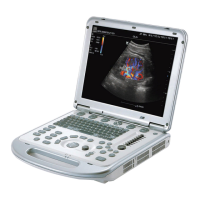Acoustic Output 17-5
17.7 Acoustic Output
17.7.1 Derated Ultrasonic Output Parameters
In order to determine the relevant Ultrasonic Output Parameters, a method is used which
allows for the comparison of ultrasound systems which operate at different frequencies
and are focused at different depths. This approach, called "derating" or "attenuating",
adjusts the acoustic output as measured in a water tank to account for the effect of
ultrasound propagation through tissue. By convention, a specific average intensity
attenuation value is used, which corresponds to a loss of 0.3 dB/cm/MHz. That is, the
intensity of ultrasound will be reduced by 0.3 dB/MHz for every centimeter of travel from
the transducer. This can be expressed by the following equation:
)10/3.0-(
10
zf
wateratten
c
II
××
×=
Where I
atten
is the attenuated intensity, I
water
is the intensity measured in a water tank (at
distance z), fc is the center frequency of the ultrasound wave (as measured in water), and
z is the distance from the transducer. The equation for attenuating pressure values is
similar except that the attenuation coefficient is 0.15 dB/cm/MHz, or one-half the intensity
coefficient. The intensity coefficient is double the pressure coefficient because intensity is
proportional to the square of pressure.
Although the attenuation coefficient chosen, 0.3 dB/cm/MHz, is significantly lower than
any specific solid tissue in the body, this value was chosen to account for fetal
examinations. In early trimester ultrasound fetal examinations, there may be a significant
fluid path between the transducer and the fetus, and the attenuation of fluid is very small.
Therefore the attenuation coefficient was lowered to account for this case.
17.7.2 Limits of Acoustic Output
In accordance with the FDA Track 3 requirements, the derating (or attenuated) approach
was incorporated into the FDA Acoustic Output Limits, as listed below. The maximum
acoustic output level from any transducer in any operating mode is expected to fall below
these limits.
FDA Maximum Acoustic Output Limits for Track 3 (Attenuated Values)
Application
I
spta.3
(mW/cm
2
)
I
sppa.3
(W/cm
2
)
or
MI
Regions
(except eyes)
720 ≤ 190 ≤ 1.9
17.7.3 Differences between Actual and Displayed MI
and TI
In operation, the system will display to the operator the Acoustic Output Parameters
Thermal Index, TI, or Mechanical Index, MI (or sometimes both parameters
simultaneously). These parameters were developed as general indicators of risk from
either thermal or mechanical action of the ultrasound wave. They serve to indicate to the
operator whether a particular setting of the system increases or decreases the possibility

